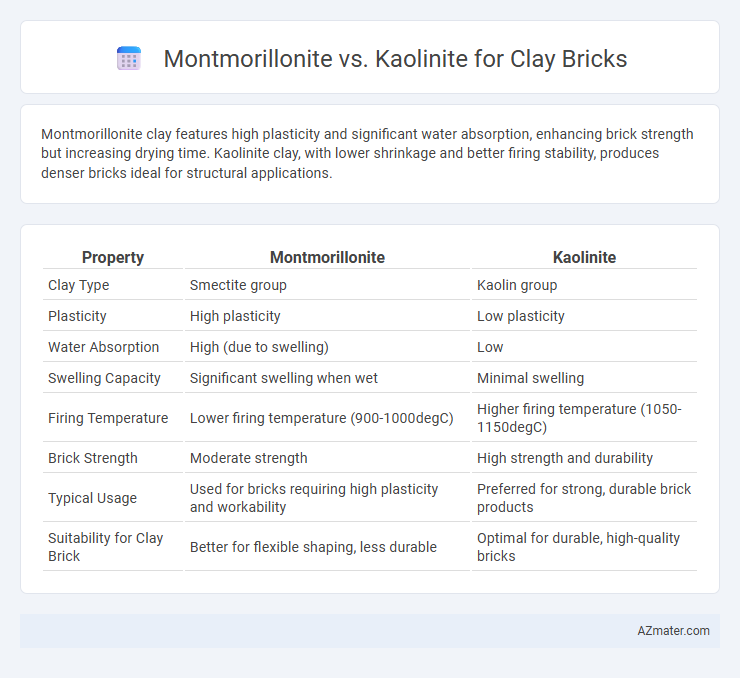Montmorillonite clay features high plasticity and significant water absorption, enhancing brick strength but increasing drying time. Kaolinite clay, with lower shrinkage and better firing stability, produces denser bricks ideal for structural applications.
Table of Comparison
| Property | Montmorillonite | Kaolinite |
|---|---|---|
| Clay Type | Smectite group | Kaolin group |
| Plasticity | High plasticity | Low plasticity |
| Water Absorption | High (due to swelling) | Low |
| Swelling Capacity | Significant swelling when wet | Minimal swelling |
| Firing Temperature | Lower firing temperature (900-1000degC) | Higher firing temperature (1050-1150degC) |
| Brick Strength | Moderate strength | High strength and durability |
| Typical Usage | Used for bricks requiring high plasticity and workability | Preferred for strong, durable brick products |
| Suitability for Clay Brick | Better for flexible shaping, less durable | Optimal for durable, high-quality bricks |
Introduction to Clay Minerals in Brick Manufacturing
Montmorillonite and kaolinite are key clay minerals widely used in brick manufacturing due to their distinct physical and chemical properties. Montmorillonite, a smectite group clay, offers high plasticity and water absorption, enhancing moldability but requiring controlled drying to prevent cracking. Kaolinite, a 1:1 layered silicate mineral, provides stability and strength due to its low shrink-swell capacity, making it essential for producing durable, uniform clay bricks.
Overview of Montmorillonite and Kaolinite
Montmorillonite and kaolinite are two primary clay minerals used in the production of clay bricks, each with distinct properties impacting brick quality. Montmorillonite is a smectite clay characterized by high swelling capacity and plasticity, which enhances workability but may cause dimensional instability during drying and firing. Kaolinite, a non-expanding 1:1 clay mineral, offers lower plasticity yet provides strength and durability in fired bricks, resulting in a more stable and dense final product.
Chemical Composition Differences
Montmorillonite clay contains a higher proportion of montmorillonite minerals composed mainly of smectite group silicates with significant amounts of magnesium, aluminum, and iron ions, contributing to its swelling properties. Kaolinite clay primarily consists of kaolinite minerals characterized by a 1:1 layer silicate structure rich in aluminum silicate with low magnesium and iron content, resulting in minimal expansion during drying. The chemical composition difference significantly impacts the plasticity, shrinkage, and firing behavior of clay bricks made from these materials.
Particle Size and Morphology Comparison
Montmorillonite particles are finer and exhibit a flaky, plate-like morphology, enhancing plasticity and water retention in clay bricks, while Kaolinite has larger, more rigid, and stacked particle structures that contribute to lower shrinkage and greater strength. The particle size of Montmorillonite typically ranges below 2 microns, promoting better workability, in contrast to Kaolinite particles that are slightly coarser, often above 2 microns, affecting the brick's texture and firing characteristics. This particle size and morphology difference influences the brick's mechanical properties and durability, making Montmorillonite more suitable for shaping and Kaolinite for structural integrity.
Plasticity and Workability in Brick Formulation
Montmorillonite offers higher plasticity and water absorption compared to Kaolinite, enhancing the workability and moldability of clay bricks. Kaolinite provides lower plasticity with reduced shrinkage, resulting in improved dimensional stability but less deformability during shaping. Optimizing clay brick formulations often involves balancing Montmorillonite's superior plasticity with Kaolinite's structural stability to achieve desired strength and finish.
Firing Behavior: Montmorillonite vs Kaolinite
Montmorillonite exhibits higher plasticity but undergoes significant shrinkage and swelling during firing, often leading to cracks in clay bricks, whereas kaolinite offers more stable firing behavior with minimal deformation due to its lower shrink-swell capacity. Montmorillonite typically requires lower firing temperatures but can produce bricks with lower mechanical strength, while kaolinite demands higher temperatures to achieve vitrification and enhanced durability. The mineralogical composition of kaolinite favors the formation of mullite crystals, improving brick hardness, whereas the presence of montmorillonite may cause fluxing and glassy phase formation, impacting brick porosity and strength.
Mechanical Strength of Finished Bricks
Montmorillonite clay significantly reduces the mechanical strength of finished clay bricks due to its high shrink-swell capacity and tendency to absorb water, leading to increased porosity and weaker structural integrity. Kaolinite, with its stable, low-expansion plate-like particles, contributes to higher compressive strength and durability in fired bricks by promoting better particle packing and minimal deformation during drying and firing. Studies show bricks with predominant kaolinite content exhibit superior mechanical properties, including higher flexural strength and resistance to cracking compared to those with elevated montmorillonite levels.
Water Absorption and Durability
Montmorillonite clay exhibits high water absorption due to its expansive lattice structure, which can compromise the durability of clay bricks by promoting increased moisture retention and subsequent weathering. In contrast, kaolinite has a stable, non-expansive structure leading to lower water absorption, resulting in clay bricks with enhanced durability and resistance to freeze-thaw cycles. The selection of kaolinite-rich clay is often preferred for brick production where long-term strength and reduced water permeability are critical performance factors.
Cost and Availability of Montmorillonite and Kaolinite
Montmorillonite is generally less expensive and more abundant than kaolinite, making it a cost-effective choice for clay brick manufacturing. Kaolinite, known for its higher purity and better plasticity, tends to be more costly and less readily available, often extracted from specific deposits. The regional availability of these clay minerals significantly influences the overall cost and supply chain efficiency in brick production.
Optimal Clay Blends for High-Quality Bricks
Montmorillonite and kaolinite differ significantly in clay brick production, with montmorillonite offering high plasticity and water retention, enhancing brick moldability and drying control. Kaolinite, prized for its minimal shrinkage and increased firing stability, ensures structural integrity and a smooth finish in bricks. Optimal clay blends for high-quality bricks often combine montmorillonite's workability with kaolinite's durability, resulting in bricks that balance plasticity, strength, and firing performance.

Infographic: Montmorillonite vs Kaolinite for Clay Brick
 azmater.com
azmater.com